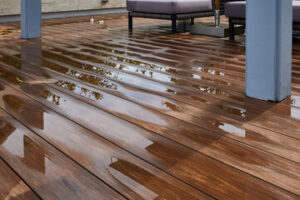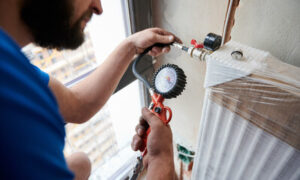Plumbing is a system of pipes that facilitates water delivery and waste removal. This is important for sanitation, heating and cooling, and overall health.

The first step in becoming a plumber is to complete a technical course or trade school program. Then, start an apprenticeship with a plumbing company to gain on-the-job experience. Visit https://www.plumbing-express.com/ to learn more.
Plumbing involves the installation, repair and maintenance of pipes, fixtures and other parts that transport water in a building or structure. The main function of a plumbing system is to supply clean water for consumption and remove wastewater in a safe and efficient manner. It is the plumber’s job to ensure that these systems are functioning properly and meeting all applicable standards.
New construction projects often require plumbers to set up the piping before the walls are closed up. This includes installing a new water supply line from the municipal water source to the house, as well as sewage lines from the house to the sewer line or septic tank. When working on new construction, plumbers must follow the blueprints closely to ensure that all pipes fit correctly and meet all necessary requirements for safety and quality.
When laying pipe in existing buildings, plumbers must carefully disassemble the old plumbing and clean the area where the new piping will be installed. They then measure and cut the pipes to size before inserting them into the openings. Once the piping is in place, plumbers test it for leaks and make sure all connections are secure.
Plumbers also install drains and vents for plumbing systems in homes and businesses. These include toilet and sink drains, shower drains, bathtub drains and floor drains. It is important for these drains to be vented properly, as they can create back pressure hazards if not. Also, they must be able to handle the flow of water and waste without overflowing or backing up.
Another part of plumbing installation is setting up gas lines for heating and cooking. This is a specialized job that requires knowledge of local building codes and regulations. Plumbers must also be able to work with gas suppliers and make sure that all connections are made correctly.
For plumbing in a new home, the plumber must determine the best location for the sewage line. This is based on the number of bathrooms and other appliances that will be using the line. It is important that the sewage line be located as close to the house sewer line as possible, to minimize cost and disruption. In some cases, a septic tank may be required, in which case the plumber must be familiar with local regulations and builder’s standards.
Repair
A plumbing system consists of pipes, valves, faucets, and fixtures that convey water and other liquids to and from appliances and fixtures. The fluids carried by the plumbing system include drinking water, heating and cooling waters, and sewage and waste water. Plumbers repair or replace these fixtures and parts to ensure the smooth flow of fluids through a building’s pipes.
When a part of the plumbing system is not functioning properly, it can cause problems with water supply, water pressure, drainage, or even structural integrity. Typical problems include clogged drains, leaky faucets or pipes, and low water pressure. Plumbers have the tools and expertise to resolve these issues quickly and efficiently.
For the do-it-yourselfer, plumbing repairs can be a simple fix with the right knowledge and materials. For example, a dripping faucet can be fixed by turning off the water supply and removing the faucet. This will stop the drip and save you money on your water bill. If the problem is a leaking pipe, you can find the source of the leak by looking for evidence such as stains on the ceiling or walls, water spots, mold, mildew, and puddles around the leak.
Maintenance
A plumbing system is composed of pipes, fixtures and appliances that deliver potable water to a home or business and remove waste. It is important to note that not all plumbing systems are the same, and each one requires special attention in order to function properly. Plumbing systems that are neglected can lead to costly damage and a number of other issues, including health hazards for building occupants. As such, plumbing maintenance is a vital part of any commercial or residential property.
Many plumbing problems can be prevented with routine inspections and maintenance services. These services include cleaning drains, examining toilets for signs of leaks and other problems, and ensuring that all components are in good working order. Professional plumbers use a variety of tools and techniques to perform these tasks, including video cameras and other diagnostic equipment. In addition to performing routine maintenance, plumbers can also assist with plumbing design and installation, plumbing repair, and emergency services.
Most plumbing professionals recommend that homeowners conduct a visual inspection of their plumbing systems at least once a year. This will allow them to catch any potential problems early on and address them before they become worse. In addition, it is a good idea to have a professional plumber inspect your plumbing system before and after any major renovations or construction projects. This will ensure that all components are in good working condition and that your new plumbing is up to code.
Performing regular plumbing maintenance can help you save money on your energy bills and reduce the amount of water that is wasted in your home or business. For example, by fixing leaky faucets and shower heads, you can prevent water wastage and lower your utility bills. Additionally, by regularly checking your toilets for cracks or clogs, you can keep them functioning properly and avoid costly repairs in the future.
A plumber is a tradesperson who specializes in the installation, repair and maintenance of plumbing fixtures and pipes. Plumbers are usually licensed and insured, and they must complete an apprenticeship program to learn their craft. There are several different types of plumbers, and each one has a specific area of expertise. Some specialize in residential plumbing, while others focus on commercial or industrial installations. While most plumbers are self-employed, some work for large companies or municipalities.
Design
Plumbing is the system of pipes, fixtures, and fittings that distribute water for drinking, cooking, washing, and bathing. It also includes the disposal of waste water in a home or other building. Plumbing systems can be complex and require professional installation. This system is essential to the health and comfort of occupants. It is important to design a plumbing system that prevents water loss and minimizes the risk of leaks. It is also important to use high quality materials and hire certified plumbers. Poor plumbing systems can lead to expensive repairs later on.
A well-designed plumbing system can save energy and money, while ensuring that water is available at all times. It is important to group rooms with similar plumbing needs together, such as kitchens and bathrooms. This can help reduce waste and save on pipe sizes. It is also important to use efficient plumbing fixtures, and to keep water temperature low to avoid wastage.
When designing a plumbing system, it is important to consider the source of the water supply. This will affect the size of the pipes and how much pressure is required to push water through them. The plumbing system should be designed to avoid any backpressure hazards or back siphonage, and it must be able to withstand the amount of water being used in the house.
The plumbing system in a house is composed of two separate systems, the water supply and the drain-waste-vent (DWV) system. The water supply system carries water into the house from the public water main, and the DWV system takes waste away from the home. The system uses vent stacks to move the water and waste to the sewer system.
During the design process, it is essential to have a detailed and comprehensive plan for each room in the house that requires plumbing. This includes the bathroom, kitchen, laundry room, and outdoor areas. The plan should include the type and size of fixtures, as well as where they will be placed in each room. It is also important to consider the layout of the rooms, as it can impact the placement of plumbing fixtures. For example, if the rooms are located on opposite sides of the house, it may be necessary to run plumbing pipes across the ceiling. This can cost more money, and may cause problems with the electrical system.








